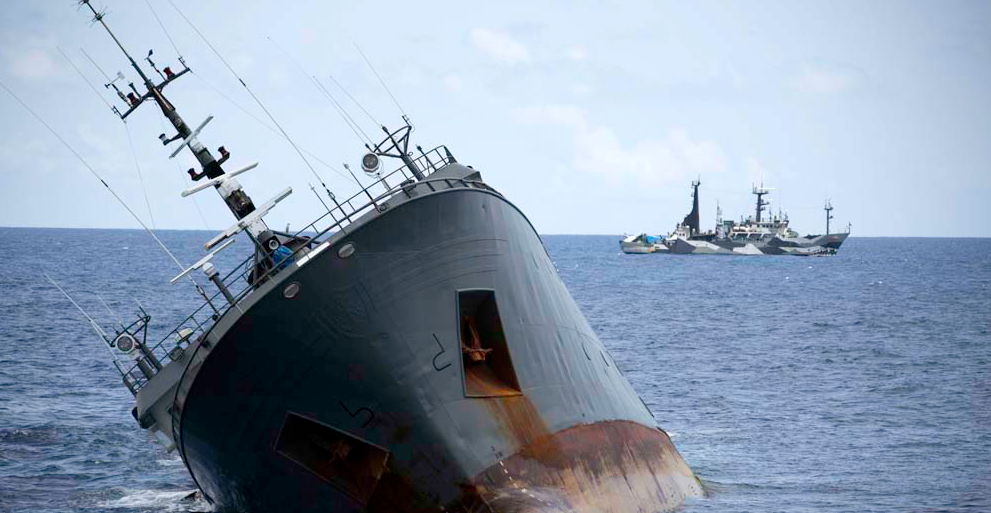By Valérie Le Brenne
Translation: Lawrence Myers
Passage au crible n° 126
 Source: Sea Shepherd
Source: Sea Shepherd
On April 6, 2015, the Thunder sank in the waters of São Tomé and Principe. Accused of illegal, unreported and unregulated fishing (IUU) and suspected of human trafficking, this vessel flying the Nigerian flag was the subject of a purple notice given by Interpol in 2003. The captain of the Bob Barker – a Sea Shepherd ship launched in pursuit of the poacher more than one hundred days ago – immediately declared that it was a matter of scuttling.
> Historical background
> Theoretical framework
> Analysis
> References
Historical background
Since 2003, Interpol member states have regularly been solicited by the organization within the framework of the notice published regarding the Thunder. More specifically, Australia, Norway and New Zealand asked authorities to communicate all information concerning its “location, its activities, people and networks and those benefitting from their illegal activities” .
Built in Norway in 1969, this ship – more than 61 meters long – was cataloged under six different names between 1986 and 2013: Arctic Ranger, Rubin, Typhoon I, Wuhan Nº4, Kuko and Thunder. Besides that, it simultaneously sailed under more than six flags: the United Kingdom, Saint Vincent and the Grenadines, Seychelles, Belize, Togo, Nigeria and Mongolia. For the boats implicated in illicit activities, these incessant modifications aim to escape surveillance by the Regional Fisheries Management Organization (RFMO). Accused of illegally fishing the toothfish – a fish that lives in the depths of the Southern Ocean and whose flesh, popular in Asian countries, is sold at extremely elevated prices -, the Thunder is on the list of smugglers reported by the CCAMLR (Commission for the Conservation of Antarctic Marine Living Resource).
Anxious to preserve this species, the NGO Sea Shepherd – an organization that intervenes on behalf of the protection of fishery resources – launched Operation Icefish last September. To do this, two boats were armed to track the poachers. For more than one hundred days, the Bob Barker followed the Thunder in order to intercept it. Simultaneously, activists recovered abandoned nets that contained more than seven hundred toothfish and other dead animals.
While the Bob Barker benefitted from food provisions at the end of March, the Thunder found itself short on supplies and fuel. Unable to dock and also limited in its possibilities of transshipment, the captain allegedly decided to sink his own vessel in the hopes of destroying any incriminating evidence. According to a press release from Sea Shepherd, the organization supposedly kept its valves open to speed up the waterway and empty holds.
Theoretical framework
1. Transnational criminality. Inherited from the Roman res communis, freedom of movement and exploration constitute the fundamental rule of the high seas. Outside of territorial waters, ships are only subject to laws of the states where they are registered. However, the transformation of the registration system after World War II, carried out in order to facilitate maritime transport, fostered the emergence of flags of convenience. In so doing, poachers are able to avoid rules imposed by the RFMO. Given the high value of the most vulnerable fish species, they can therefore count of a monopoly rent that guarantees the sustainability of their criminal activities.
2. The appearance of a sovereignty-free authority. The lack of a means of coercion is prompting some sovereignty-free actors to develop their own means of control. Thus, we are witnessing a growing convergence between international organizations and private actors to fight against illegal fishing.
Analysis
In 1982, the signing of the United Nations Convention on the Law of the Sea in Montego Bay marked a major turning point in maritime jurisdiction. By codifying customary practices, the text notably instituted the EEZ (exclusive economic zone) principle, which accords sovereignty over an area of two hundred thousand nautical miles to any state claiming it. The convention also created the International Tribunal for the Law of the Sea, which is responsible for judging litigation resulting from the delimitation of these areas.
However, the negotiations between maritime powers and new coastal states have not resulted in the creation of a clear status for the high seas. Contrary to the seabed, which no state is authorized to claim ownership over, the overlying waters remain free from traffic and exploitation. Only the RFMO intervenes in the management of fishery resources. But while they establish quotas and adopt technical measures, these international organizations have inadequate means for surveillance and control.
In a context marked by the intensification of global captures, this system has hardly been sufficient to curb illegal practices. Moreover, the rarefication of several species contributes to increase of their value, particularly in illegal networks. The breadth of risks reducing de facto the number of actors liable to engage in this type of poaching, the smugglers benefit from a monopoly rent, which makes this trade very lucrative.
During the 1990s, the increase in IUU captures of toothfish led the CCAMLR to adopt a series of binding measures for fleets fishing in its waters. Six times greater than the authorized volume, these catches seriously endangered stocks, all the while affecting the activity of fishermen respectful of regulations. If the establishment of TAC (Total Allowable Catches) and the obligation to take an observer on board have reduced this phenomenon, multiple pirate ships continue to withdraw from these vulnerable ecosystems. As they sail under several flags and do not respect the rules in matters of satellite signalization, the latter are completely outside the control of the concerned authorities. Moreover, they carry out their campaigns in several regions of the ocean, making operations to apprehend them particularly complex.
In these conditions, many NGOs acting in favor of the preservation of marine resources are involved in the fight against illegal fishing. Like the methods used by Greenpeace, Sea Shepherd developed a repertoire of spectacular action, which consists of tracking ships in order to prevent them from casting their nets. Although some of these actions remain questionable – the founder of Sea Shepherd, Paul Watson, remains within the scope of an international Interpol arrest warrant at the request of Costa Rica -, their impact is involved in the building of a legitimate capital. Within the framework of its program Scale, Interpol has for example partnered with the American foundation the PEW Research Center in preparation for the fight against this transnational criminality. Thus, we are currently witnessing a process of convergence of expertise between private stakeholders and international organizations.
References
OCDE, Pourquoi la pêche pirate perdure. Les ressorts économiques de la pêche illégale, non déclarée et non réglementée, Paris, OCDE, 2006.
Revue internationale et stratégique (Éd.), Mers et océans, 95 (3), 2014, 206 p.
Strange Susan, Le Retrait de l’État. La dispersion du pouvoir dans l’économie mondiale, [1996], trad., Paris, Temps Présent, 2011.




